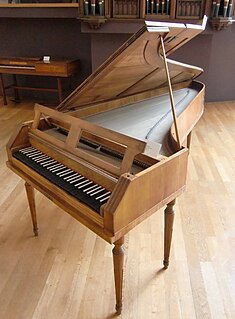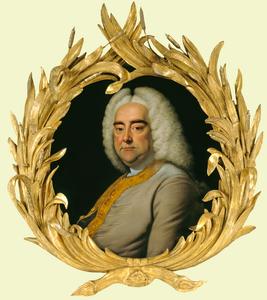
Johann Christoph Friedrich Bach was a harpsichordist and composer, the fifth son of Johann Sebastian Bach, sometimes referred to as the "Bückeburg Bach".

A piano concerto is a type of concerto, a solo composition in the Classical music genre which is composed for a piano player, which is typically accompanied by an orchestra or other large ensemble. Piano concertos are typically virtuoso showpieces which require an advanced level of technique on the instrument, including melodic lines interspersed with rapid scales, arpeggios, chords, complex contrapuntal parts and other challenging material. When piano concertos are performed by a professional concert pianist, a large grand piano is almost always used, as the grand piano has a fuller tone and more projection than an upright piano. Piano concertos are typically written out in music notation, including sheet music for the pianist, orchestra parts for the orchestra members, and a full score for the conductor, who leads the orchestra in the accompaniment of the soloist.
A harpsichord concerto is a piece of music for an orchestra with the harpsichord in a solo role. Sometimes these works are played on the modern piano. For a period in the late 18th century, Joseph Haydn and Thomas Arne wrote concertos that could be played interchangeably on harpsichord, fortepiano, and pipe organ.
Piano Concerto No. 3 in C major, Op. 26, is a piano concerto by Sergei Prokofiev. It was completed in 1921 using sketches first started in 1913.
In music, a pasticcio or pastiche is an opera or other musical work composed of works by different composers who may or may not have been working together, or an adaptation or localization of an existing work that is loose, unauthorized, or inauthentic.

L'estro armonico, Antonio Vivaldi's Op. 3, is a set of 12 concertos for stringed instruments, first published in Amsterdam in 1711. Vivaldi's Twelve Trio Sonatas, Op. 1, and Twelve Violin Sonatas, Op. 2, only contained sonatas, thus L'estro armonico was his first collection of concertos appearing in print. It was also the first time he chose a foreign publisher, Estienne Roger, instead of an Italian. Each concerto was printed in eight parts: four violins, two violas, cello and continuo. The continuo part was printed as a figured bass for violone and harpsichord.
Concerto Moon is a Japanese Neoclassical metal / Power metal band formed in 1996 and led by guitarist Norifumi Shima.
The Oboe Concerto in D minor, S D935, is an early 18th-century concerto for oboe, strings and continuo attributed to the Venetian composer Alessandro Marcello. The earliest extant manuscript containing Johann Sebastian Bach's solo keyboard arrangement of the concerto, BWV 974, dates from around 1715. As a concerto for oboe, strings and continuo its oldest extant sources date from 1717: that year it was printed in Amsterdam, and a C minor variant of the concerto, S Z799, was written down.

Mozart's Piano Concerto No. 11 in F major, K. 413, was the second of the group of three early concertos he wrote when in Vienna, in the autumn of 1782. It was the first full concerto he wrote for the subscription concerts he gave in the city. The autograph is held by the Jagiellońska Library, Kraków with an additional, now incomplete, copy that Mozart brought to Salzburg in 1783, in the library of the Archabbey of St Peter's, Salzburg. The concerto is in the usual three movements:
- Allegro in 3
4
- Larghetto in 4
4
- Tempo di menuetto in 3
4
The Piano Concertos, K. 107 are three keyboard concertos by Wolfgang Amadeus Mozart, based on sonatas by Johann Christian Bach. These sonatas are from J.C. Bach's Op. 5; Mozart turned Sonata No. 2 in D, Sonata No. 3 in G, and Sonata No. 4 in E♭ from this set into the three concertos of K. 107.
The harpsichord concertos, BWV 1052–1065, are concertos for harpsichord, strings and continuo by Johann Sebastian Bach. There are seven complete concertos for a single harpsichord, three concertos for two harpsichords, two concertos for three harpsichords, and one concerto for four harpsichords. Two other concertos include solo harpsichord parts: the concerto BWV 1044, which has solo parts for harpsichord, violin and flute, and Brandenburg Concerto No. 5 in D major, with the same scoring. In addition, there is a nine-bar concerto fragment for harpsichord which adds an oboe to the strings and continuo.
Joseph Haydn's Keyboard Concerto No. 11 in D major was written between 1780 and 1783, and published in 1784. It was originally composed for harpsichord or fortepiano and scored for an orchestra in a relatively undeveloped galant style evident in his early works, and has a lively Hungarian Rondo finale. On the other hand, being a somewhat later composition, it also shows more similarities to Mozart's piano concertos than do Haydn's other keyboard concertos. Haydn and Mozart had probably become acquainted by 1784, which may explain the Mozartian influences that are discernible in the work. It consists of three movements:
- Vivace
- Un poco adagio
- Rondo all'Ungarese

The Handel organ concertos Op 7, HWV 306–311, refer to the six organ concertos for organ and orchestra composed by George Frideric Handel in London between 1740 and 1751, published posthumously in 1761 by the printing company of John Walsh. They were written for performance during Handel's oratorios, contain almost entirely original material, including some of his most popular and inspired movements.

The concerto transcriptions of Johann Sebastian Bach date from his second period at the court in Weimar (1708–1717). Bach transcribed for organ and harpsichord a number of Italian and Italianate concertos, mainly by Antonio Vivaldi, but with others by Alessandro Marcello, Benedetto Marcello, Georg Philipp Telemann and the musically talented Prince Johann Ernst of Saxe-Weimar. It is thought that most of the transcriptions were probably made in 1713–1714. Their publication by C.F. Peters in the 1850s and by Breitkopf & Härtel in the 1890s played a decisive role in the Vivaldi revival of the twentieth century.








